overheating MERCEDES-BENZ S CLASS 2019 Owners Manual
[x] Cancel search | Manufacturer: MERCEDES-BENZ, Model Year: 2019, Model line: S CLASS, Model: MERCEDES-BENZ S CLASS 2019Pages: 578, PDF Size: 23.31 MB
Page 175 of 578
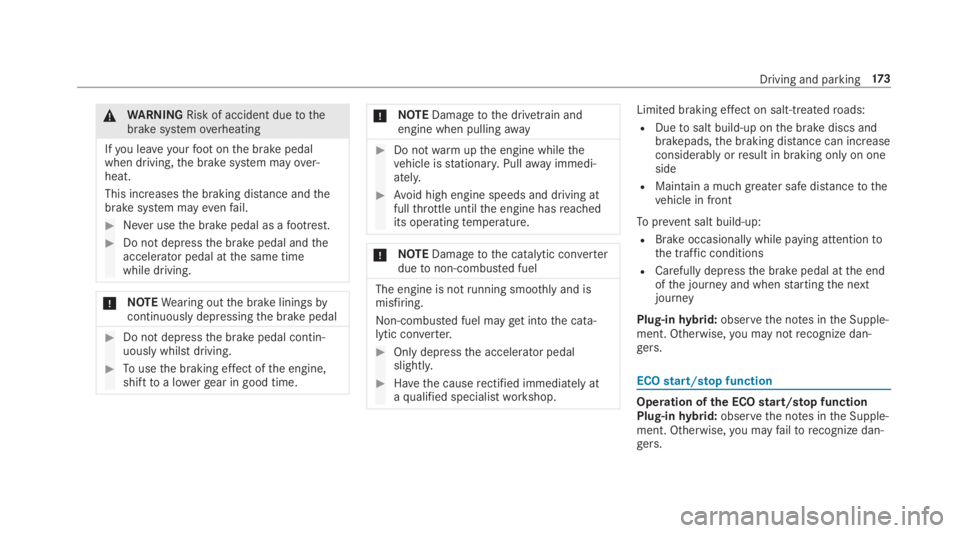
&WARNINGRisk of accident duetothebrake systemoverheating
Ifyou leaveyourfootonthe brake pedalwhen driving,the brake system mayover‐heat.
This increasesthe braking distance andthebrake system mayevenfail.
#Never usethe brake pedal as afootrest.
#Do not depressthe brake pedal andtheaccelerator pedal atthe same timewhile driving.
*NOTEWearing outthe brake liningsbycontinuously depressingthe brake pedal
#Do not depressthe brake pedal contin‐uously whilst driving.
#Tousethe braking effect ofthe engine,shifttoa lowergear in good time.
*NOTEDamagetothe drivetrain andengine when pullingaway
#Do notwarmupthe engine whilethevehicle isstationary.Pullawayimmedi‐ately.
#Avoid high engine speeds and driving atfullthrottle untilthe engine hasreachedits operatingtemperature.
*NOTEDamagetothe catalytic converterduetonon-combusted fuel
The engine is notrunning smoothly and ismisfiring.
Non-combusted fuel mayget intothe cata‐lytic converter.
#Only depressthe accelerator pedalslightly.
#Havethe causerectified immediately ataqualified specialistworkshop.
Limited braking effect on salt-treatedroads:
RDuetosalt build-up onthe brake discs andbrakepads,the braking distance can increaseconsiderably orresult in braking only on oneside
RMaintain a much greater safe distancetothevehicle in front
Toprevent salt build-up:
RBrake occasionally while paying attentiontothe traffic conditions
RCarefully depressthe brake pedal atthe endofthe journey and whenstartingthe nextjourney
Plug-inhybrid:observethe notes inthe Supple‐ment. Otherwise,you may notrecognize dan‐gers.
ECOstart/stop function
Operation of the ECOstart/stop functionPlug-inhybrid:observethe notes inthe Supple‐ment. Otherwise,you mayfailtorecognize dan‐gers.
Driving and parking17 3
Page 418 of 578
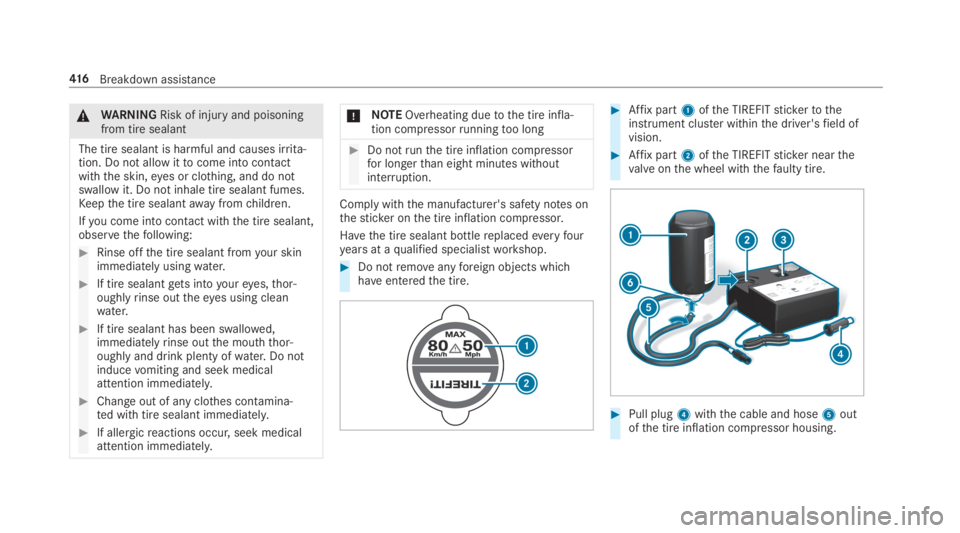
&WARNINGRisk of injuryand poisoningfrom tire sealant
The tire sealant is harmful and causes irrita‐tion. Do not allow ittocome into contactwith the skin,eyes or clothing, and do notswallow it. Do not inhale tire sealant fumes.Keepthe tire sealantawayfromchildren.
Ifyou come into contact withthe tire sealant,observethefollowing:
#Rinse offthe tire sealant fromyour skinimmediately usingwater.
#If tire sealantgets intoyoureyes,thor‐oughlyrinse outtheeyes using cleanwater.
#If tire sealant has been swallowed,immediatelyrinse outthe mouththor‐oughly and drink plenty ofwater.Do notinducevomiting and seek medicalattention immediately.
#Change out of any clothes contamina‐ted with tire sealant immediately.
#If allergicreactions occur, seek medicalattention immediately.
*NOTEOverheating duetothe tire infla‐tion compressorrunningtoo long
#Do notrunthe tire inflation compressorfor longerthan eight minutes withoutinterruption.
Comply withthe manufacturer's safety notes onthesticker onthe tire inflation compressor.
Havethe tire sealant bottlereplacedeveryfouryears at aqualified specialistworkshop.
#Do notremoveanyforeign objects whichhaveenteredthe tire.
#Affix part1ofthe TIREFITstickertotheinstrument cluster withinthe driver'sfield ofvision.
#Affix part2ofthe TIREFITsticker nearthevalve onthe wheel withthefaulty tire.
#Pull plug4withthe cable and hose5outofthe tire inflation compressor housing.
416Breakdown assistance
Page 438 of 578

RThe tires maywearexcessively and/orunevenly,which maygreatlyimpair tiretraction.
RThe drivingcharacteristics, aswell assteering and braking, may be greatlyimpaired.
#Comply withtherecommended tirepressure andcheckthe tire pressure ofall tires includingthe spare wheelregu‐larly:
Rat least once a month
Rwhenthe loadchanges
Rbefore embarking on a longer journey
Rif operating conditionschange, e.g. off-road driving
#Adjustthe tire pressure as necessary.
Driving withtire pressurethat istoo high ortoolow can:
RShortenthe service life ofthe tires.
RCause increased tire damage.
RAdversely affect drivingcharacteristics andthus driving safety,e.g. dueto hydroplaning.
&WARNINGRisk of an accident duetoinsufficient tire pressure
Tires with pressurethat istoo low canover‐heat and burstas aresult.
In addition,theyalso suffer fromexcessiveand/or irregularwear, which can significantlyimpairthe braking properties andthe han‐dlingcharacteristics.
#Avoidexcessively low tire pressures inallthe tires, includingthe spare wheel.
Tirepressure which istoo low can cause:
RTiredefects as aresult ofoverheating
RImpaired handlingcharacteristics
RIrregularwear
RIncreased fuel consumption
&WARNINGRisk of accident fromexces‐sive tire pressure
Tires withexcessively high pressure canburst becausetheyare damaged more easilybyhighwayfill, pot holesetc.
In addition,theyalso suffer from irregularwear, which can significantly impairthe brak‐ing properties andthe handlingcharacteris‐tics.
#Avoidexcessively high tire pressures inallthe tires, includingthe spare wheel.
Excessively high tire pressure canresult in:
RIncreased braking distance
RImpaired handlingcharacteristics
RIrregularwear
RImpaired driving comfort
RSusceptibilitytodamage
436Wheels and tires
Page 449 of 578
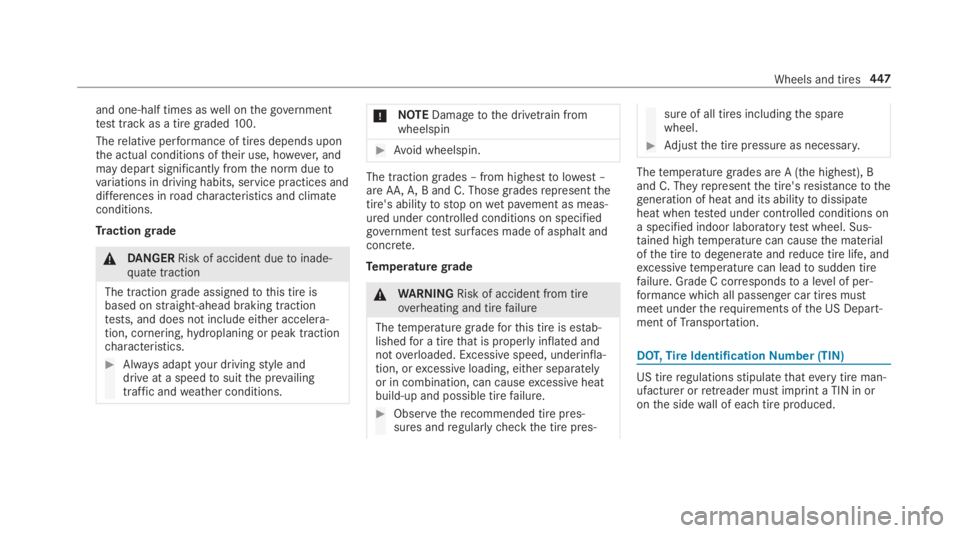
and one-half times aswell onthe governmenttesttrack as a tire graded100.
Therelative performance of tires depends uponthe actual conditions oftheir use, however,andmay depart significantly fromthe norm duetovariations in driving habits, service practices anddifferences inroadcharacteristics and climateconditions.
Tractiongrade
&DANGERRisk of accident duetoinade‐quate traction
The tractiongrade assignedtothis tire isbased onstraight-ahead braking tractiontests, and does not include either accelera‐tion, cornering,hydroplaning or peak tractioncharacteristics.
#Always adaptyour drivingstyle anddrive at a speedtosuitthe prevailingtraffic andweather conditions.
*NOTEDamagetothe drivetrain fromwheelspin
#Avoid wheelspin.
The traction grades – from highesttolowest –are AA,A,B and C. Those gradesrepresentthetire's abilitytostop onwet pavement as meas‐ured under controlled conditions on specifiedgovernmenttestsurfaces made of asphalt andconcrete.
Temperaturegrade
&WARNINGRisk of accident from tireoverheating and tirefailure
Thetemperature gradeforthis tire is estab‐lishedfor a tirethat is properly inflated andnotoverloaded. Excessive speed, underinfla‐tion, orexcessive loading, either separatelyor in combination, can causeexcessive heatbuild-up and possible tirefailure.
#Observetherecommended tire pres‐sures andregularlycheckthe tire pres‐
sure of all tires includingthe sparewheel.
#Adjustthe tire pressure as necessary.
Thetemperature grades are A (the highest), Band C. Theyrepresentthe tire'sresistancetothegeneration of heat and its abilitytodissipateheat whentested under controlled conditions ona specified indoor laboratorytestwheel. Sus‐tained hightemperature can causethe materialofthe tiretodegenerate andreduce tire life, andexcessivetemperature can leadtosudden tirefailure. Grade C correspondstoa level of per‐formance which all passenger car tires mustmeet undertherequirements ofthe US Depart‐ment ofTransportation.
DOT,TireIdentificationNumber (TIN)
US tireregulationsstipulatethateverytire man‐ufacturer orretreader mustimprint a TIN in oronthe sidewall of each tire produced.
Wheels and tires447
Page 475 of 578
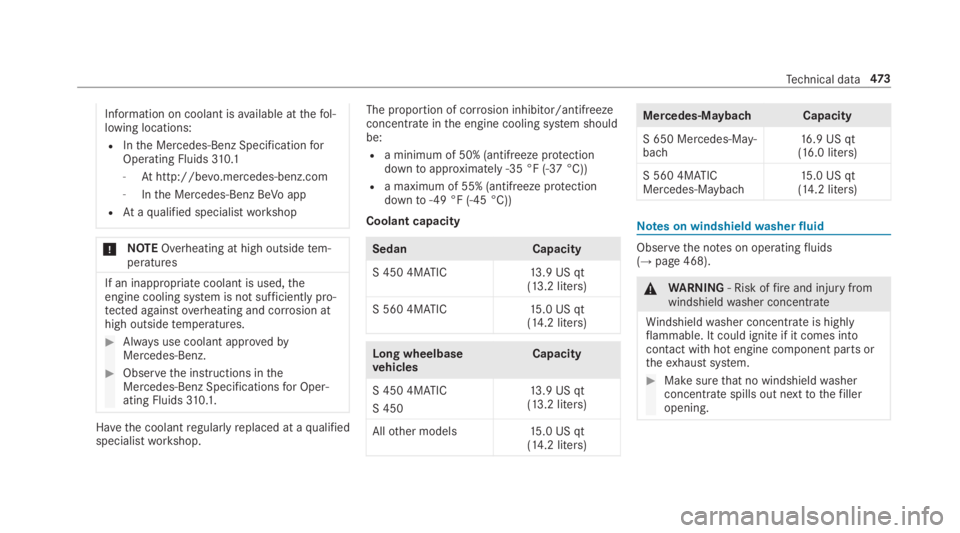
Information on coolant isavailable atthefol‐lowing locations:
RInthe Mercedes-Benz SpecificationforOperating Fluids310.1
-Athttp://bevo.mercedes-benz.com
-Inthe Mercedes-Benz BeVo app
RAtaqualified specialistworkshop
*NOTEOverheating at high outsidetem‐peratures
If an inappropriate coolant is used,theengine cooling system is not sufficiently pro‐tected againstoverheating and corrosion athigh outsidetemperatures.
#Always use coolant approvedbyMercedes-Benz.
#Observethe instructions intheMercedes-Benz Specificationsfor Oper‐ating Fluids310.1.
Havethe coolantregularlyreplaced at aqualifiedspecialistworkshop.
The proportion of corrosion inhibitor/antifreezeconcentrate inthe engine cooling system shouldbe:
Ra minimum of 50% (antifreeze protectiondowntoapproximately -35 °F (-37 °C))
Ra maximum of 55% (antifreeze protectiondownto-49 °F (-45 °C))
Coolant capacity
SedanCapacity
S 450 4MATIC13.9 US qt(13.2 liters)
S 560 4MATIC15.0 US qt(14.2 liters)
Long wheelbasevehiclesCapacity
S 450 4MATIC
S 450
13.9 US qt(13.2 liters)
Allother models15.0 US qt(14.2 liters)
Mercedes‑MaybachCapacity
S 650 Mercedes-May‐bach16.9 US qt(16.0 liters)
S 560 4MATICMercedes-Maybach15.0 US qt(14.2 liters)
Notes on windshieldwasher fluid
Observethe notes on operatingfluids(→page 468).
&WARNING‑ Risk offireand injury fromwindshieldwasher concentrate
Windshieldwasher concentrate is highlyflammable. It could ignite if it comes intocontact withhot engine component parts ortheexhaust system.
#Make surethat no windshieldwasherconcentrate spills out nexttothefilleropening.
Technical data473
Page 516 of 578
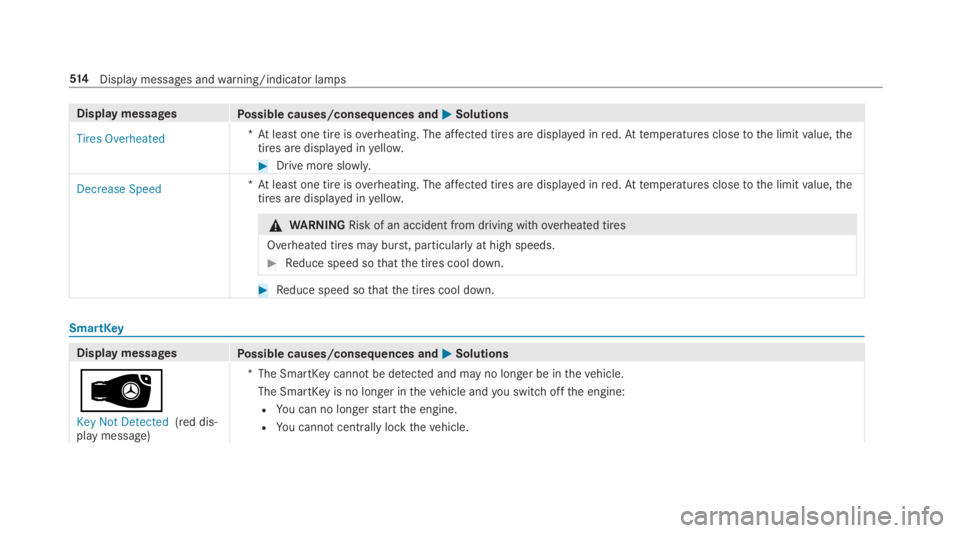
Display messagesPossible causes/consequences and�P�PSolutions
Tires Overheated*At least one tire isoverheating. The affected tires are displayed inred.Attemperatures closetothe limitvalue,thetires are displayed inyellow.
#Drive more slowly.
Decrease Speed*At least one tire isoverheating. The affected tires are displayed inred.Attemperatures closetothe limitvalue,thetires are displayed inyellow.
&WARNINGRisk of an accident from driving withoverheated tires
Overheated tires may burst, particularly at high speeds.
#Reduce speed sothatthe tires cool down.
#Reduce speed sothatthe tires cool down.
SmartKey
Display messagesPossible causes/consequences and�P�PSolutions
�